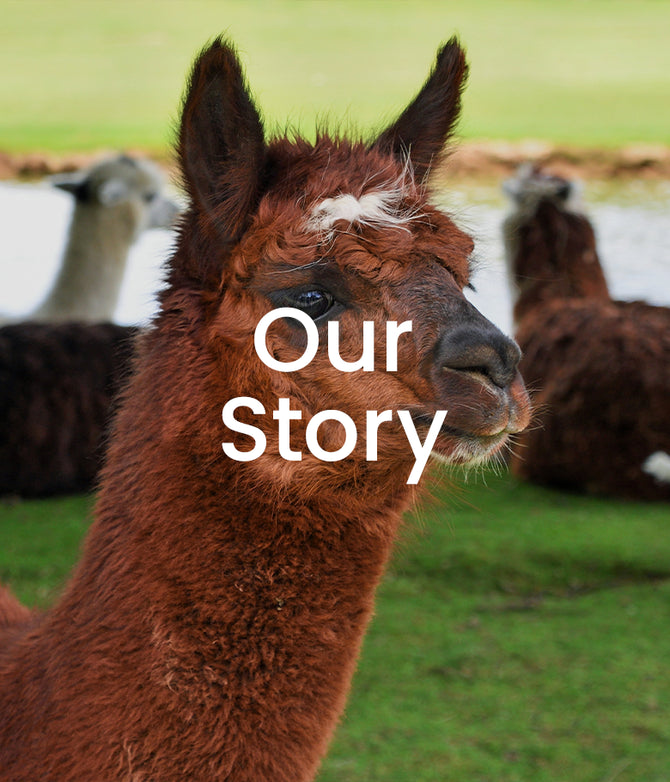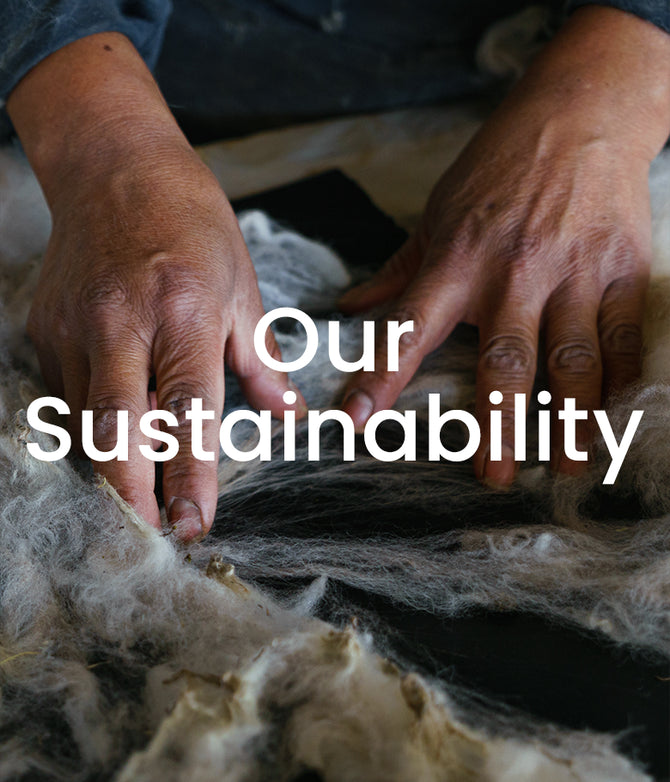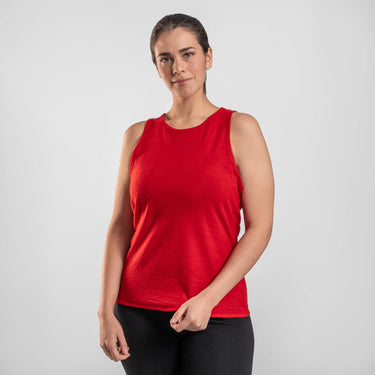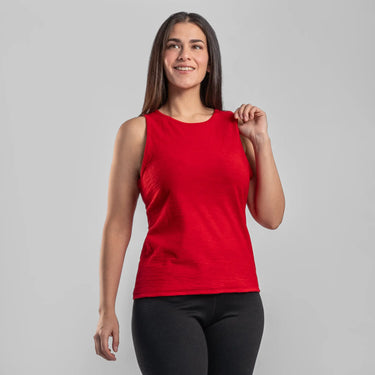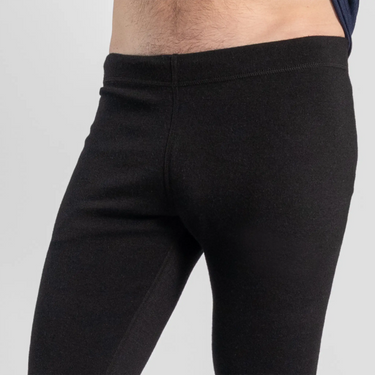WHAT ARE MICROPLASTICS IN THE FASHION INDUSTRY?
Published June 14, 2021
What are microplastics?
Microplastics are plastic particles smaller than 5 millimeters released from any type of plastic into the environment. Plastic fragments smaller than 1 micrometer, resulting from the degradation of plastic objects, are referred to as nanoplastics.
Microplastics are divided into two categories according to their origin:
Primary microplastics (15-31%)

Plastic bits that are directly released into the environment as small fragments.
- Textile microfibers
- Microplastics released from tires
- City dust
- Plastic beads in beauty products
Secondary microplastics (69-81%)

Larger plastics that break down into small particles over time through the process of fragmentation.
- Plastic bottles
- Fishing nets
- Plastic bags
- Plastic food containers
Microplastics & fashion
Common fibers used in clothing, such as polyester, nylon, lycra and acrylic, are produced from petrochemicals and, as such, are classed as plastics. This means that these synthetic textiles release microplastic fibers into the environment. According to The International Union for Conservation of Nature, 35% of primary microplastics that end up in the oceans come from textiles. [1]
How are microplastics released from clothing?

Washing
The release of plastic microfibers during washing of synthetic textiles in a laundry machine is mainly caused by the mechanical and chemical actions that occur during the washing process.
On average, 9 million plastic microfibers are released from each load of laundry we do. [2]

Wearing
Natural body movement creates friction which causes a release of microplastics from clothing made of synthetic fibers.
According to a recent study, a synthetic coat weighing around 1kg releases 1,200 microplastic fibers into the air, during each hour of use. [3]
Does one shirt make a difference?
If you wear a polyester t-shirt every day for 10 hours and wash it once a week, approximately 562 million plastic microfibers will shed from it into the environment per year. [4]
Where do microplastics end up?

Water
The majority of potable water in the world, whether bottled or tap water, is contaminated with microplastics.
Bottled water, for instance, on average contains 4 plastic bits per liter.
They have also been found in other beverages, such as beer, milk and soda drinks.

Food
On average, we ingest 50,000 microplastics per year through water and food.
Microplastics have been found in different amounts in some of the most commonly consumed products, such as salt, sugar, rice, fish, shellfish.

Air
Plastic microfibers are released into the air during use of synthetic clothing and home textiles, so this means that we breathe in up to 68,000 plastic microfibers per year! [5]
Researchers discovered that 22,000 tons of microplastics are released into the air across the US each year. [6]
What is the impact of microplastics on human health?
Microplastics and nanoplastics enter the human body mainly through ingestion and inhalation, and in a smaller amount also through sweat glands, hair follicles and wounds in the skin. Due to their small size, nanoplastics can cross cellular membranes and affect the functioning of cells in fish. However, we do not know yet how nanoplastics affect human health. [7]
Some types of plastics contain highly toxic ingredients that are classified as carcinogenic, mutagenic or toxic, but their long-term impact on human health is still being researched by scientists. Currently, there is still not enough evidence showing direct connections between plastics and specific diseases.
Dr. Shanna Swan from the Icahn School of Medicine in New York studied the influence of plastics on fertility. She discovered that certain chemical compounds used in plastics, such as phthalates and bisphenol A (BPA), have a negative effect on fertility in men, as they cause a lower production of testosterone which results in fewer sperm. According to Swan's research, the average male sperm count has declined by 50% in the past 50 years. [8]
Is fashion harming our health?
As mentioned above, research into the effects of microplastics on human health is still ongoing. But we do know that certain chemicals used in synthetic textile processing are linked to health issues.

Some textile workers who were continuously exposed to synthetic fibers during textile manufacturing, suffered with respiratory and lung problems, including coughing, shortness of breath and reduced lung capacity.
Polyethylene terephthalate (PET), the ingredient used to make plastic bottles, polyester and other synthetic fibers, contains antimony trioxide, a catalyst used in the polymerization process that produces PET. This substance can leach from PET when heated and is listed by the International Agency for Research on Cancer as “possibly carcinogenic to humans”.
In addition to PET, chemicals used in synthetic textile dyes can also be a potential threat to human health and the environment. Certain types of dyes, for instance azo dyes, release aromatic amines which are carcinogenic.
"Shedding of fiber fragments into the environment is not only about the physical presence of non-biodegradable fiber fragments in the environment; it is also about the chemicals that are carried along the fiber fragments." [9]
What impact do microplastics have on nature?
Microplastics have a great impact on both flora and fauna. The most affected animals, that scientists know of up to this day, are fish, shellfish, sea turtles and birds. According to a new study, ingestion of microplastics causes several health issues in wild fish, such as liver damage, neurotoxicity and reduced fertility. [10]

From microscopic organisms to our plates
Microplastics in the ocean can get eaten by plankton. Plankton are marine organisms, usually microscopic but some species are a larger size (e.g. jellyfish), that drift with the current and feed on marine debris. Other marine species feed on plankton which creates a chain of microplastics being passed on from one organism to another: plankton ingest microplastics, fish eat the plankton, the fish end up on our plates.




Microplastics in the ocean
Plastics and microplastics that are heavier than seawater sink to the bottom of the ocean. However, around 60% of the plastic produced is less dense than seawater which means that the majority of plastic waste ends up floating on the surface accumulating in patches. [11] Studies estimate that up to 268,000 tons of plastics are floating in the oceans. [12] Most of the plastics, floating or sunken, in the ocean will eventually become microplastics as they start breaking down.

The Great Pacific Garbage Patch
The Great Pacific Garbage Patch is the world’s largest collection of marine debris located in the North Pacific Ocean between California and Hawaii. The garbage patch takes up 1.6 million square kilometers on the ocean’s surface and also goes deep down into the ocean. Studies discovered that microplastics could contribute to up to 10% of the garbage patch. [13]
Dianna Parker from National Ocean Service says: “If you tried to clean up less than 1% of the North Pacific Ocean, it would take 67 ships one year to clean up that portion... Until we prevent debris from entering the ocean at the source, it's just going to keep congregating in these areas.”
Microplastics in soil
While more scientific evidence is needed, there is concern that microplastics are becoming a threat to biodiversity and all types of eco-systems. Microplastics in the air and water and be spread to and settle in the soil. Experiments have shown that the presence of microplastics in soil reduces its fertility, pH level, and most common species such as ants, moths, butterflies, flies and mites. Since plastic production and the amount of microplastics in the environment is still growing, this could have severe consequences on agriculture.
The world's highest mountain with microfibers
Scientists from the University of Plymouth in the United Kingdom analyzed snow samples from Mount Everest and discovered that even the world's tallest peak is contaminated with microplastics.
They detected most microplastics accumulating in the areas where people camp, containing around 30 pieces of microplastics per quart of water. A large portion of the microplastics found was made of synthetic fibers such as polyester, nylon, and acrylic. These fibers are commonly used in hiking and camping gear.
The future of plastics
The production of polyester, as well as overall plastic production, is still steadily growing. Altough the plastic industry is coming up with new environmentally friendly (?) solutions, there still need to be better options.
Some of these innovative solutions include:
Recycled polyester
Recycled polyester reduces the negative environmental impact of manufacturing new polyester textile.
However, even though recycled polyester saves resources and energy used in the production, it still sheds as much plastic microfibers as regular polyester.
Microplastic filter for washing machine
Microplastic filter stops microplastics from entering into the wastewater system.
However, while microfilters seem to prevent microplastics from directly entering water systems, they are only a temporary and partial solution. Microplastics still enter the environment when you clean out the filter and they still shed from the garment during use and on disposal.
Pectin finishings
Pectin based finishings reduce the amount of microplastics released from polyamide fabrics, such as nylon, by 90% compared to untreated fibers.
However, although pectin finishings do seem to help prevent shedding of microplastics during use and washing, it just delays the inevitable: plastic microfibers still enter the environment when the garment is disposed of.
"If we keep using plastics the way we do now, by 2050 there could be more plastics in the sea than fish by weight."
- Ellen MacArthur Foundation
What can we do to help with plastic pollution?
As individuals

You can help stop pollution. Avoid using unnecessary plastics, such as single use plastics (bags, bottles, containers) and synthetic textiles, and educate people in your circle.
As a society
As a community we can stop pollution and polyester production. If the public holds large companies that use/produce plastics accountable and demands change, we can start combating a large source of plastic pollution.
When purchasing a new product, ask yourself first: "Will this product leave a trace in the environment?"

NO
Think twice! Do you really need it? Is it worth polluting our planet?
NOT SURE
Do more research! Read our article 'What is sustainability?'
YES
Buy it if you need it, and recommend it to others!

YES
NOT SURE
NO
Think twice! Do you really need it? Is it worth polluting our planet?
Do more research! Read our article 'What is sustainability?'
Buy it if you need it, and recommend it to others!
Resources
1 The International Union for Conservation of Nature: Primary Microplastics
in the Oceans
2 Plastic Soup Foundation: Ocean Clean Wash
3 Environ. Sci. Technol. 2020, 54, 6, 3288–3296
4 Arms of Andes calculations based on research by Plastic Soup Foundation: Ocean Clean Wash and Environ. Sci. Technol. 2020, 54, 6, 3288–3296
5 Plastic Soup Foundation: Ocean Clean Wash
6 Constraining the atmospheric limb of the plastic cycle
7 J.A. Pitt, J.S. Kozal, N. Jayasundara, A. Massarsky, R. Trevisan, N. Geitner, et al.: Uptake, tissue distribution, and toxicity of polystyrene nanoparticles in developing zebrafish, Aquat. Toxicol., 194 (2018), pp. 185-194
8 Dr. Shanna Swan: Count Down
9 Textile Exchange: Preferred Fiber Material Market Report 2020
10 Science of The Total Environment Volume 717, 15 May 2020, 134625
11 Andrady, A. L. Microplastics in the marine environment (2011)
12 Eriksen et al. (2014) and Sebille et al. (2015)
13 The Ocean Clean Up: The Pacific Garbage Patch








